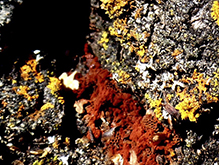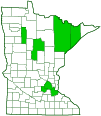wasp nest slime mold
(Metatrichia vesparium)
Conservation • Description • Habitat • Ecology • Distribution • Taxonomy
|
|
||||||||||||||
Description |
Wasp nest slime mold is a common and widespread plasmodial slime mold. It is found in Europe, Asia, Africa, Australia, and North and South America. In the United States it is common east of the Great Plains, including Minnesota, less common in the west. It grows in open forests on dead and rotting wood, especially hardwood. The fruiting body (sporocarp) may be attached directly to the substrate (sessile) or rise in a densely crowded group of up to twelve on a common stalk (stipitate). The spore-producing structures (sporothecae) are less than ⅛″ (2.5 mm) in height, and about 1 ⁄32″ (0.4 to 0.7 mm) in diameter. They are almost cylinder-shaped or cone-shaped to almost egg-shaped, and have a distinct convex lid (operculum) on top. The outer skin consists of two or three layers: an outer, tough, cartilaginous, dark red or reddish-purple to nearly black layer; and an inner membranous layer. The operculum is shiny, iridescent, and dark red or reddish-purple to nearly black. When mature, it swings open like a jack-in-the-box, and the interior expands outward. The expanded interior consists of a few fibers (capillitia) interspersed with the spores. The capillitia are very long, coiled, and red. The spore mass is bright red or rust-red. When it dries out, the spores are disbursed by wind. Eventually, the expanded portion disintegrates. What is left looks like the nest of a paper wasp, giving this slime mild its common name. |
Similar Species |
Habitat and Hosts |
Open forests. Dead wood. |
Ecology |
Season |
|
Distribution |
||
|
Sources Biodiversity occurrence data published by: Minnesota Biodiversity Atlas (accessed through the Minnesota Biodiversity Atlas Portal, bellatlas.umn.edu, 7/1/2025). |
|
| 7/1/2025 | ||
Occurrence |
||
Widespread and common |
||
Taxonomy |
|
Kingdom |
Protozoa (protozoans) |
Phylum |
Mycetozoa (slime molds) |
Class |
Myxomycetes (true slime molds) |
Subclass |
Lucisporomycetidae |
Superorder |
Trichiidia |
Order |
Trichiales |
Family |
Trichiaceae |
Genus |
Metatrichia |
Higher ranking Species gender |
|
Subordinate Taxa |
|
|
|
Synonyms |
|
Arcyria rubiformis Arcyria rubiformis var. plasmodiocarpa Arcyria rubiformis var. sessilis Craterium porphyrium Hemiarcyria ellisii Hemiarcyria rubiformis Hemiarcyria rubiformis var. neesiana Hemiarcyria rubiformis var. tubulina Hemiarcyria vesparia Hemiarcyria vesparia var. sessilis Hemitrichia rubiformis Hemitrichia vesparia Hemitrichia vesparia var. mirabilis Hemitrichia vesparia var. neesiana Lycoperdon vesparium Metatrichia vesparium Mucor pyriformis Stemonitis cinnabarina Stemonitis vesparia Trichia ayresii Trichia chalybea Trichia fragiformis Trichia neesiana Trichia pyriformis Trichia rubiformis var. laevis Trichia rubiformis var. minor Trichia rubiformis var. pulverulenta |
|
Common Names |
|
wasp nest slime mold |
|
Visitor Photos |
||
Share your photo of this slime mold. |
||
This button not working for you? |
||
Luciearl |
 |
MinnesotaSeasons.com Photos |
||
|

Slideshows |
|

Visitor Videos |
||
Share your video of this slime mold. |
||
This button not working for you? |
||
|
Other Videos |
||
Wasp Nest Slime Mold, Metatrichia vesparium |
About
Published on Aug 16, 2017 Hey everyone! In today's video I talk a little bit about one of my favorite slime molds, the wasp nest slime mold. Like most myxomycetes, there has been a disappointing lack of research done on this organism, but I tried to provide what I could find both online and in the literature. All photos and illustrations are mine. Blog: Microcosmia.com |

Created: 11/12/2018 Last Updated: © MinnesotaSeasons.com. All rights reserved. |


